James H. White & Frederick Blechynden
Part II: Train Actualities
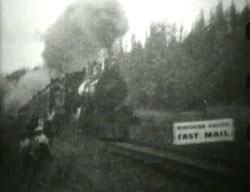 A railroad scene titled Fast Mail, Northern Pacific R. R. (1897), shows a speeding twelve-car train. Such scenes were so commonly filmed for kinetoscope & nickelodean viewings that "train rushing at ya" was practically a genre unto itself.
A railroad scene titled Fast Mail, Northern Pacific R. R. (1897), shows a speeding twelve-car train. Such scenes were so commonly filmed for kinetoscope & nickelodean viewings that "train rushing at ya" was practically a genre unto itself.
The train is first seen in the distance. On the far side of the track is a "Fast Mail" sign, which was put there for the sake of the film & is not natural to the scene.
On the nearer side of the track some railroad workers have accumulated. The engine rushes past, & the individual cars are filmed sharp & clear, one after another.
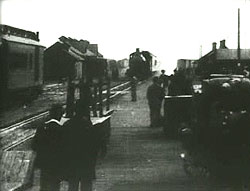 Another episode in the same "Northern Pacific Railway Series" is Overland Express Arriving at Helena, Mont. (copyright 1900, but filmed in 1897) shows the N. P. Railway Overland Express rushing toward the camera. It's pulling four express cars & seven pullmans. Another episode in the same "Northern Pacific Railway Series" is Overland Express Arriving at Helena, Mont. (copyright 1900, but filmed in 1897) shows the N. P. Railway Overland Express rushing toward the camera. It's pulling four express cars & seven pullmans.
The train is coming into a busy train station, easing to a halt, picking up awaiting passengers while others disembark. This should've been a bit more interesting than most specimens of "train coming at ya" genre, but that the film has darkened so much more than usual, & the activities in the station are not often easily observed.
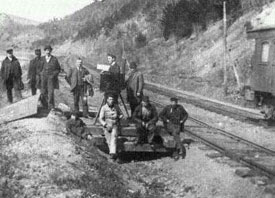 James H. White & Frederick Blechynden made "train actualities" galore during their journey west making films for the Edision Company. All westward subjects were up for grabs, but trains were highlighted more than any single subject. James H. White & Frederick Blechynden made "train actualities" galore during their journey west making films for the Edision Company. All westward subjects were up for grabs, but trains were highlighted more than any single subject.
This was large the result of the railroads underwriting White's & Blechynden's journey. But it's also the result of filmmakers' tendency, from the roots of cinema right up to today, to just copy one another.
Trains pulling into stations made a big impact in the earliest cinema, as for example the Lumiere brothers' Arrival of a Train at La Ciotat (Arrivee d'un train a la Coitat, 1895); or trains rushing at & past the viewer, as in James White's & William Heise's Black Diamond Express (1896; photo of the film crew is above this paragraph); & the especially novel "phantom ride" actualities in which we get a view of where the train is headed as though riding on the cow-catcher, for example, Cecil Hepworth's View from an Engine Front (1898).
All of these types of train films are represented in the westward journey group. Of these the "phantom ride" films are invariably the most interesting as they stop focusing on a train rolling on the track & give us instead regional countrysides, tunnels, & the simple thrill of this unique view from in front of the locomotive.
Phantom ride films also engage the imagination, for instead of watching a train on which others journey, we must instead feel as if we are ourselves perched on that cow-catcher, & must imagine the train's unseen presence at our back.
Such may be the most obvious & extreme example to recur in early cinema of the "window" of information projected on a screen implying a much larger world than is actually visible, as we know full well there's a train present witlhout ever seeing it.
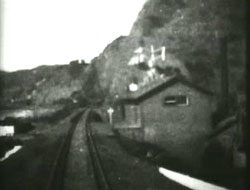 A nifty phantom ride film from the Southern Pacific Company "Sunset Route" series is Going Through the Tunnel (1898). The camera is mounted on the locomotive's front, so it's a classic case of the train invisibly behind the viewer, the tracks centered on the screen before. A nifty phantom ride film from the Southern Pacific Company "Sunset Route" series is Going Through the Tunnel (1898). The camera is mounted on the locomotive's front, so it's a classic case of the train invisibly behind the viewer, the tracks centered on the screen before.
The tunnel in question is somewhere near Santa Monica. Enough variety is given the scene that it's just about as good as actualities get, even if not as engaging as films with stories to tell.
The journey opens in a train yard with boxcars parked on side-rails. We quickly round a corner & enter into the darkness of a tunnel, light not yet visible at the other end because the tunnel bends sharply.
The light of the almost hexagonal opening appears & quickly we're again in the daylight. There's a flagger practically on the tracks who takes off running into the lower right hand corner to avoid being killed!
Passing under an overhead walkway with pedestrians thereon, we seem almost to be on the "open rails" with a hillside to our right. There's then an unexpected jump-cut as we see what is apparently the same locomotive rushing at another flagger, then jump-cuts back to the phantom-ride view from the cow-catcher.
Most phantom ride films don't show even this glimpse of the train. The editing was unfamiliar enough that a contemporary catalog mistakenly described it as a train coming from the other direction, which it is not, because there is only one set of rails.
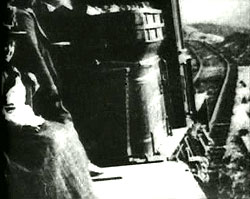 Mount Tamalpais R.R. No. 2 (1898) is again in the Southern Pacific Company "Sunset Route" series. It doesn't fully qualify as a complete phantom ride because it's not from the p.o.v. of the cow-catcher, & we don't have to merely imagine the train nor even the passenger. Mount Tamalpais R.R. No. 2 (1898) is again in the Southern Pacific Company "Sunset Route" series. It doesn't fully qualify as a complete phantom ride because it's not from the p.o.v. of the cow-catcher, & we don't have to merely imagine the train nor even the passenger.
Rather, most unexpectedly, we are given a partial-shot of a woman seated behind the locomotive engineer on a wooden open-air platform or flatbed.
This is a most unlikely place for any passenger to be seated, & we're given no explanation for it, but it does incite the imagination. The woman barely moves a muscle, either fearful due to her improbable perch, or for fear of interfering with the camera shoot.
As the train winds curves along tracks on a mountain ledge, it has the effect of the camera pivoting, though it's the train that bends, & the woman with her legs in teh shot would seem to be in a harrowing position, albeit one for a grand view.
When the train winds to the right we, the locomotive obscures the view, & when it veers left, we see vistas of Mount Tamalpais.
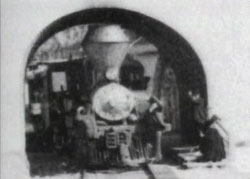 Mount Tamalpais R. R. No. 1 (1898) isn't as harrowing a perspective but it's more interesting than most barrelling-at-you films because it captures the train coming out of an interesting tunnel. Mount Tamalpais R. R. No. 1 (1898) isn't as harrowing a perspective but it's more interesting than most barrelling-at-you films because it captures the train coming out of an interesting tunnel.
The location is the mountain summit, where there was a tavern resort, & a sweeping view of San Francisco Bay. The rails had been recently palced, in 1896, & the ride to a height of over 2,400 feet immediately became a popular weekend excursion route for local Marin County residents & far travellers to San Francisco.
This is also a more complex little film than Henry & Fred generally composed throughout their western journeyings. It begins with a shot of the tavern, probably taken from the rear coach as the unseen locomotive the S. S. Cushing backs toward the resort. The building's Spanish-influenced adobe architecture is typical of California.
A tunnel that is really only an adobe archway appears & fills the screen like a telescoping shot, as the rear train approaches the arch. Beyond the arch is another locomotive, the Joseph G. Eastman. It is parked & still but ready to go, steam billowing from its broad chimney.
The tunnel vanishes overhead & we see some passengers from the Joseph G. Eastman entering the tavern. Before the Cushing stops, there's a jump cut, & we're already exiting the tunnel, with the Eastman following close behind, two men riding the cow-catcher, women tourists strolling nearby.
The camera then pivots for a panoramic view of the interesting architecture then the mountain's second peak. Most Edison cameras of this period only provided stationary shots unless mounted on a turning base, but the camera used by Blechynden was not an Edison product, & it did have marginal panning ability. Edison cameras of the time required electricity, which White & Blechynden knew would not be easily had on their longer journeys, & Blechynden very likely had his own equipment from another manufacturer.
There is no view over the valley because there's a fog below, & it seems brilliant in its novelty that the filmmakers permit the screen to go entirely white as though filmed in an empty universe.
Slowly the Joseph G. Eastman with the men still on the cow-catcher come back into view, as the train continues to circle the peak, as this is just a short run away from & back to the resort, taken for the sake of the view.
Mount Tamalpais R. R. No. 1 is a stunning film of its kind, containing so much more than one comes to expect from the bulk of the western journey actualities.
Although it is numbered "no. 1" by its contemporary title, it is consecutively the second as the no. 2 shows the train on the way to the summit, & No. 1 shows it at the summit. This led to some confusion in some texts, with No. 2 mislabeled No. 1 in order to number them consecutively.
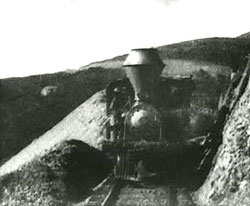 Mount Taw R. R., No. 3 (1897) has also been known as Mount Tamalpais R. R., No. 3. Mount Taw was a nickname for Mt. Tamalpais. Mount Taw R. R., No. 3 (1897) has also been known as Mount Tamalpais R. R., No. 3. Mount Taw was a nickname for Mt. Tamalpais.
The first two films of this "trilogy" showed the upward mountain journey. The third shows the descent. Edison Manufacturing Company sold these three films to exhibitors either as a set, or separately.
Nearly two minutes in duration, the downward journey has a feeling of urgency & speed as the train rounds bends revealing a variety of mountain ridge scenery.
It's a "phantom ride" journey with camera on cow catcher so we don't see the train. But we do see a second locomotive up ahead. It has two passenger coaches, & it is running backward down the mountain.
Since we can't see the train we're "riding" I suppose it's possible it, too, is running backward down the mountain, & the camera's mounted on the caboose. But the Edison catalog asserts the camera was mounted on the front of the p.o.v. train. Not that the catalog was always right; the authors thereof weren't actually at the shoot.
Due to the sharp curves, the backward train is in & out of the picture, the stark mountain view very mutable at each bend. The scenes are sometimes obscured by the smoke from the backward engine in front of us.
The film would look more "normal" run backward. I ran it backward to see. The only give-away was that when viewed so as to make the train move foward instead of backing down the mountain, the smoke from the stack appeared to be trailing against the wind.
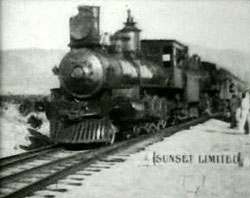 Many of these films are only a half-minute; a few appraoch two minutes. Sunset Limited, Southern Pacific Ry. (1898) is a one-minute ride. Many of these films are only a half-minute; a few appraoch two minutes. Sunset Limited, Southern Pacific Ry. (1898) is a one-minute ride.
It opens with the titular train racing into Fingal, California. As was done only occasionally, the filmmakers have set up a sign alongside the rails identifying the Sunset Limited.
Trainyard workers or flagmen stand on both sides of the track, although the man in white jacket is probably with the filmmakers since no one wears white to work around sooty locomotives.
The train is quite distant but coming at high speed so is soon dominating the screen, & as quickly rushing past. Apparently there was advance notice of the filming, as a couple young men will be seen hanging as far out of the train as they can, showing off. A number of passengers are waving scarves or hats.
Most such films would end when the train had passed, but we're soon left with just the workers by the track. A couple of them switch the rails, & another train appears going the opposite direction, off into the distance, with even more passengers hanging out of windows waving hankies.
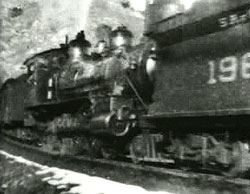 The majority of the "Sunset Route" series of train actualities filmed by Blechynden promote the tourist routes, but Freight Train (1898) captures a more practical & much longer train, one for transporting livestock or goods rather than travelers. And it's very well done of kind, giving us something unique within its genre. The majority of the "Sunset Route" series of train actualities filmed by Blechynden promote the tourist routes, but Freight Train (1898) captures a more practical & much longer train, one for transporting livestock or goods rather than travelers. And it's very well done of kind, giving us something unique within its genre.
We first see the smoking train coming out of a distant tunnel with considerable drama. It's a sharp upward incline & you can tell the engine isn't at top speed, but straining to drag its great number of boxcars up the hill.
As a distance the locomotive looks like it has two large smoke stacks. But as it comes into perfect view close-up, we see there is a locomotive, a coal car, then a second locomotive needed to get up such mountainous or steeply graded tracks.
The boxcars then begin their long passage by the camera. Most of the boxcars have an sign on the outside advertising the Sunset Route. As they pass, we see at intervals two railroad workers each standing on the roof of different boxcars, fists on hips.
When the last boxcar passes, we see the caboose, & behind that a third locomotive, known as a "pusher engine," which underscores the difficulty of this climb. The pusher engine has its own coal car & caboose.
At last the train has passed from view & the camera lingers on the tracks & on the distant tunnel, from which smoke is still spewing due to the great amount that had been spewed by the three locomotives so recently passing through. Freight Train is overall a more substantial one-minute show than the majority of train actualities, conveying more about this train's journey than one usually gets in such little snippets.
copyright © by Paghat the Ratgirl
|
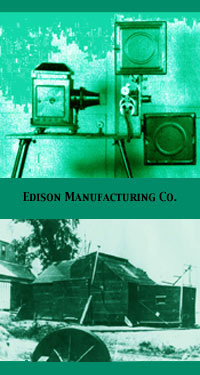

 Another episode in the same "Northern Pacific Railway Series" is Overland Express Arriving at Helena, Mont. (copyright 1900, but filmed in 1897) shows the N. P. Railway Overland Express rushing toward the camera. It's pulling four express cars & seven pullmans.
Another episode in the same "Northern Pacific Railway Series" is Overland Express Arriving at Helena, Mont. (copyright 1900, but filmed in 1897) shows the N. P. Railway Overland Express rushing toward the camera. It's pulling four express cars & seven pullmans.





